Complete Solutions to SECTION II of chapter SAMPLE QUESTION PAPER 03 of Class 10 book with complete answers and questions
| Class 10 | CHEMISTRY |
| Chapter | SAMPLE QUESTION PAPER 03 |
| OSWAL | SECTION II |
| Number Of Questions | 47 |
| Academic Year | 2023-24 |
The following question relate to the extraction of aluminium by electrolysis:
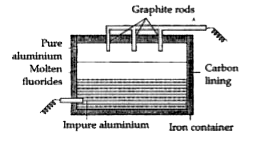
Name the other aluminium containing compound added to alumina and state its significance.03:44View SolutionThe following question relate to the extraction of aluminium by electrolysis:

Give the equation for the reaction that takes place at the cathode.01:39View SolutionThe following question relate to the extraction of aluminium by electrolysis:
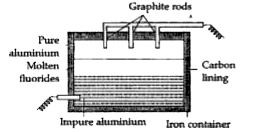
Explain why is it necessary to renew the anode periodically.01:46View SolutionThe following question is related to Iron:
Name the acid with which iron is rendered passive .02:42View SolutionThe following question are related to Iron:
Name an alloy of iron and carbon.00:55View SolutionThe following question are related to Iron:
Name the process by which iron ore is concentrated.02:17View SolutionComplete the following statements using proper words:
In a thermite mixture, aluminium ____________ (oxidises/reduces) iron (III)oxide.01:51View SolutionComplete the following statements using proper words:
In dry cells, the Zinc container acts as an _________ (anode/cathode).01:35View SolutionUse the letters only written in the Periodic Table given below to answer the questions that follow :

State the number of valence electrons in atom J.05:33View SolutionUse the letters only written in the Periodic Table given below to answer the questions that follow :

Which element shown forms ions with a single negative charge ?02:11View SolutionUse the letters only written in the Periodic Table given below to answer the questions that follow :

Which metallic element is more reactive than R?01:31View SolutionUse the letters only written in the Periodic Table given below to answer the questions that follow :
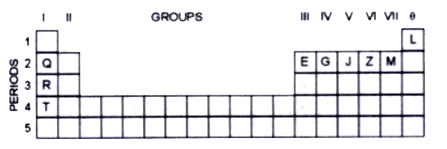
Which element has its electrons arranged in four shells ?02:19View SolutionArrange the following as per the instructions given in the brackets:
Cs, Na, Li, K, Rb (increasing order of metallic character).03:51View SolutionArrange the following as per the instructions given in the brackets:
Mg, CI, Na, S, Si (decreasing order of atomic size).04:09View SolutionArrange the following as per the instructions given in the brackets :
Na, K, Cl, S, Si (increasing order of ionization energy).04:23View SolutionArrange the following as per instructions given in the brackets:
Cl, F, Br, I (increasing order of electron affinity)05:02View SolutionBy drawing an electron dot diagram, show the lone pair effect leading to the formation of ammonium ion from ammonia gas and hydrogen ion.
03:47View SolutionIdentify the acid which matches the following description :
Give balanced chemical equations for the following conversions A, B and C :
`Fe overset(A) to FeCl_3 overset(B )to FeCO_3 overset(C ) to Fe(NO_3)_2`05:27View SolutionName a yellow monoxide that dissolves in hot and concentrated alkali. Give equation.
01:16View SolutionStudy the figure given below and answer the questions that follow :
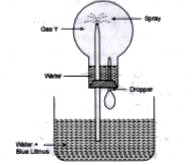
Identify the gas Y.02:28View SolutionStudy the figure given below and answer the questions that follow :
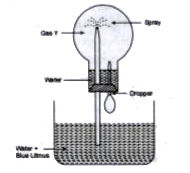
What property of gas Y does this experiment demonstrate ?02:06View SolutionStudy the figure given below and answer the questions that follow :
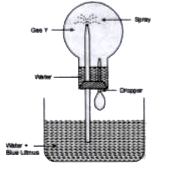
Name another gas which has the same property and can be demonstrated through this experiment.01:32View SolutionWhy is
(a) concentrated sulphuric acid kept in air tight bottles ?01:47View SolutionWhy is
`H_2SO_4` not a drying agent for `H_2S` ?02:44View SolutionCopy and Complete the following table which refers to two practical applications of electrolysis .
 02:55View Solution
02:55View SolutionThe questions below are related to the manufacture of ammonia.
Name the process.01:34View SolutionThe questions below are related to the manufacture of ammonia.
In what ratio must the reactants be taken?02:06View SolutionThe questions below are related to the manufacture of ammonia.
Name the catalyst used.02:34View SolutionThe questions below are related to the manufacture of ammonia.
Give the equation for the manufacture of ammonia.02:32View SolutionConsider the following reaction and based on the reaction answer the question that follow:
`(NH_4)_2 Cr_2 O_7 to N_2 (g) + 4H_2 O (g) + Cr_2 O_3`
Calculate :
The quantity in moles of `(NH_2)_2 Cr_2 O_7 ` if 63 gm of `(NH_4)_2 Cr_2 O_7 ` is heated .02:06View SolutionConsider the following reaction and based on the reaction answer the question that follow:
`(NH_4)_2 Cr_2 O_7 to N_2 (g) 4H_2 O (g) + Cr_2 O_3`
Calculate :
The quantity in moles of nitrogen formed if 5g of ammonium dichromate is used and the reaction is 100% efficient.04:56View SolutionConsider the following reaction and based on the reaction answer the question that follow:
`(NH_4)_2 Cr_2 O_7 to N_2 (g) 4H_2 O (g) + Cr_2 O_3`
Calculate :
The volume in litres or `dm^3` of `N_2` evolved at STP if 5 g of ammonium dichromate is used and the reaction is 100 percent efficient.04:30View SolutionConsider the following reaction and based on the reaction answer the question that follow:
`(NH_4)_2 Cr_2 O_7 to N_2 (g)+ 4H_2 O (g) + Cr_2 O_3`
Calculate :
The mass in grams of `Cr_2 O_3` formed at the same time
[Atomic massess : H= 1 , Cr = 52 , N= 14]02:33View SolutionCorrect the following if required:
`HNO_3` is a strong reducing agent.02:37View SolutionCorrect the following if required:
Nitric acid remains colourless even when exposed to light .02:12View SolutionCorrect the following:
Constant boiling nitric acid contains 80% `HNO_(3)` by weight.00:46View SolutionCorrect the following if required:
`NaNO_3` gives `NO_2` and `O_2` on heating.01:24View SolutionName the organic compound prepared by each of the following reaction:
`Al_4 C_3 + H_2 O to `02:11View SolutionName the organic compound prepared by each of the following reaction:
`C_2 H_5 Br underset("(alc and hot)")overset(KOH)to `02:06View SolutionName the organic compound prepared by the following reactions:
`C_2H_5COONa + NaOH to `02:09View SolutionName the organic compound prepared by the following reactions:
`CaC_2 + 2H_2O to `01:58View SolutionWhy is pure acetic acid known as glacial acetic acid?
01:23View Solution(i) Why is pure acetic acid known as glacial acetic acid? (ii) Give a chemical equation for the reaction between ethyl alcohol and acetic acid.
02:38View SolutionName an organic compound used as a thermometric liquid.
01:47View SolutionDraw the structural formula for the following:
3-Methyl but-1-yne01:42View SolutionDraw the structural formula for the following:
Bromoethane01:12View SolutionDraw the structural formula for the following:
Pent-2-ene01:30View Solution
SECTION II questions and complete solutions for chapter SAMPLE QUESTION PAPER 03 of EVERGREEN CHEMISTRY (ENGLISH) of Class 10
